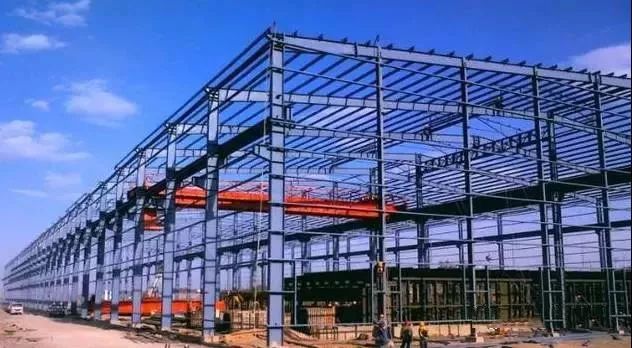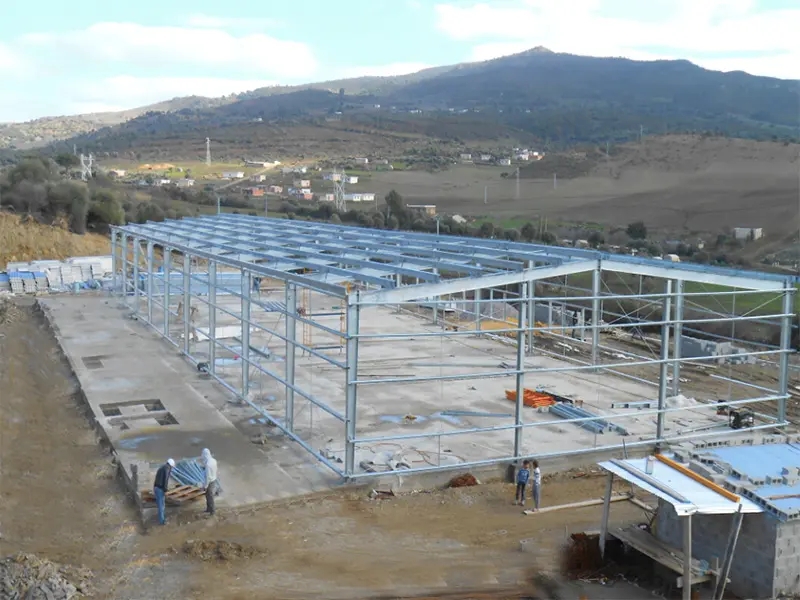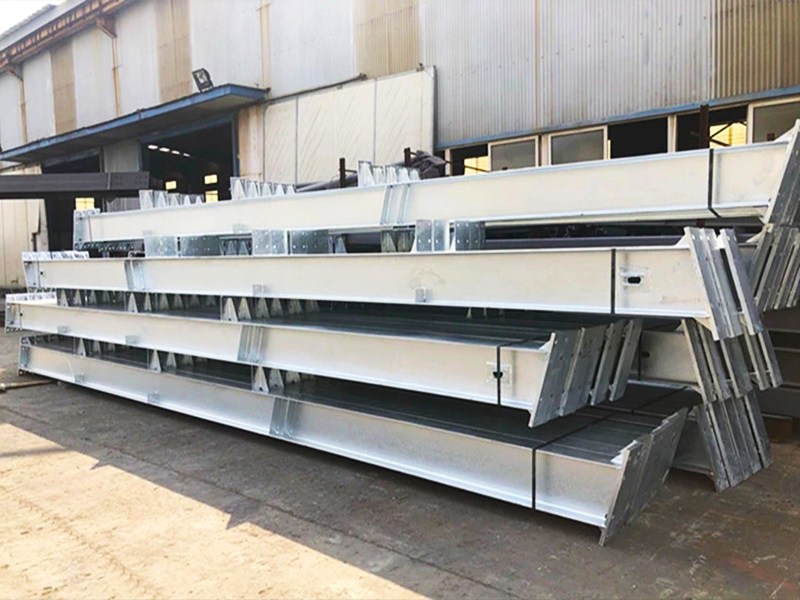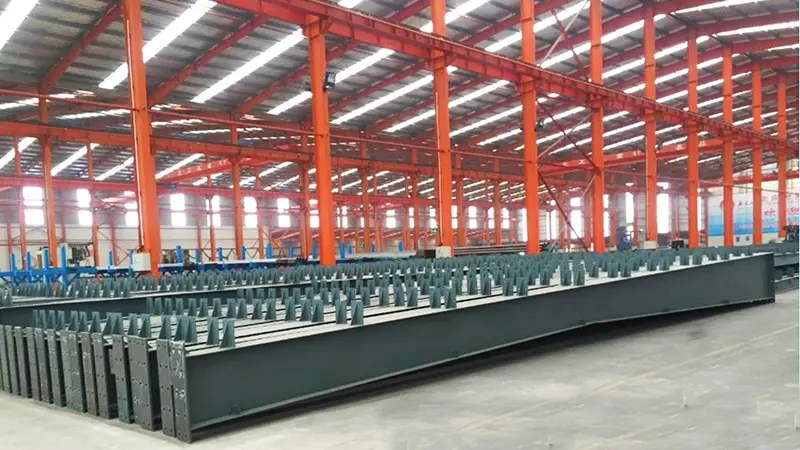How to prevent corrosion of steel structure?
With the steady increase of steel output, steel structures are more and more popular. It is widely used as warehouse,workshop,garage,prefab apartment,shopping mall,prefab stadium,etc.Compared with reinforced concrete buildings, steel structure buildings have the advantages of convenient construction, good seismic performance, less environmental pollution and recyclability. However, steel structures are easy to rust, thus anti-corrosion is very important for steel structures.

The corrosion types of steel structures include atmospheric corrosion, local corrosion and stress corrosion.
(1) Atmospheric corrosion
Atmospheric corrosion of steel structures is mainly caused by the chemical and electrochemical effects of water and oxygen in the air. The water vapor in the atmosphere forms an electrolyte layer on the metal surface, and the oxygen in the air is dissolved in it as a cathode depolarizer. They form a basic corrosive galvanic cell with steel components. After the rust layer is formed on the surface of steel members by atmospheric corrosion, the corrosion products will affect the electrode reaction of atmospheric corrosion.

(2) Local corrosion
Local corrosion is the most common in steel structure buildings, mainly galvanic corrosion and crevice corrosion. Galvanic corrosion mainly occurs at different metal combinations or connections of steel structures. The metal with negative potential corrodes faster, while the metal with positive potential is protected. The two metals constitute a corrosive galvanic cell.
Crevice corrosion mainly occurs in the surface crevices between different structural members of steel structure and between steel members and non-metal. When the crevice width can make the liquid stagnate in the crevice, the most sensitive crevice width of steel structure crevice corrosion is 0.025 ~ o.1mm.

(3) Stress corrosion
In a specific medium, the steel structure has little corrosion when it is not under stress, but after being subjected to tensile stress, the component will break suddenly after a period of time. Because there is no obvious sign of stress corrosion fracture in advance, it often leads to disastrous consequences, such as bridge collapse, pipeline leakage, building collapse and so on.
According to the corrosion mechanism of steel structure, its corrosion is a kind of uneven damage, and the corrosion develops rapidly. Once the surface of steel structure is corroded, the corrosion pit will develop rapidly from the pit bottom to depth, resulting in stress concentration of steel structure, which will accelerate the corrosion of steel, which is a vicious circle.
Corrosion reduces the cold brittleness resistance and fatigue strength of steel, resulting in the sudden brittle fracture of load-bearing components without obvious signs of deformation, resulting in the collapse of buildings.

Protection method of steel structure corrosion
1. Use weather resistant steel
Low alloy steel series between ordinary steel and stainless steel. Weathering steel is made of ordinary carbon steel with a small amount of corrosion-resistant elements such as copper and nickel. It has the characteristics of strength and toughness, plastic extension, forming, welding and cutting, abrasion, high temperature and fatigue resistance of high-quality steel; The weather resistance is 2 ~ 8 times that of ordinary carbon steel, and the coating performance is 1.5 ~ 10 times that of ordinary carbon steel. At the same time, it has the characteristics of rust resistance, corrosion resistance of components, life extension, thinning and consumption reduction, labor saving and energy saving. Weathering steel is mainly used for steel structures exposed to the atmosphere for a long time, such as railways, vehicles, bridges, towers and so on. It is used to manufacture containers, railway vehicles, oil derricks, seaport buildings, oil production platforms and containers containing hydrogen sulfide corrosive media in chemical and petroleum equipment. Its low-temperature impact toughness is also better than that of general structural steel. The standard is weathering steel for welded structures (GB4172-84).
The amorphous spinel oxide layer about 5O ~ 100 m thick formed between the rust layer and the matrix is dense and has good adhesion with the matrix metal. Due to the existence of this dense oxide film, it prevents the infiltration of oxygen and water in the atmosphere into the steel matrix, slows down the in-depth development of corrosion to steel materials, and greatly improves the atmospheric corrosion resistance of steel materials.


2. Hot dip galvanizing
Hot dip galvanizing corrosion prevention is to dip the workpiece to be plated into the molten metal zinc bath for plating, so as to form a pure zinc coating on the surface of the workpiece and a zinc alloy coating on the secondary surface, so as to realize the protection of iron and steel.


3. Arc spraying anticorrosion
Arc spraying is to use special spraying equipment to melt the sprayed metal wire under the action of low voltage and high current, and then spray it to the metal components pre sanded and derusted by compressed air to form arc sprayed zinc and aluminum coatings, which are sprayed with anti-corrosion sealing coatings to form a long-term anti-corrosion composite coating. The thicker coating can effectively prevent the corrosive medium from dipping into the substrate.
The characteristics of arc spraying anti-corrosion are: the coating has high adhesion, and its adhesion is unmatched by zinc rich paint and hot-dip zinc. The results of impact bending test on the workpiece treated with arc spraying anti-corrosion treatment not only fully meet the relevant standards, but also known as "laminated steel plate"; The anti-corrosion time of arc spraying coating is long, generally 30 ~ 60A, and the coating thickness determines the anti-corrosion life of the coating.

4. Anti corrosion of thermal sprayed aluminum (zinc) composite coating
Thermal spraying aluminum (zinc) composite coating is a long-term anti-corrosion method with the same effect as hot-dip galvanizing. The process is to remove the rust on the surface of the steel member by sand blasting, so that the surface is exposed with metallic luster and roughened; Then use acetylene oxygen flame to melt the continuously sent aluminum (zinc) wire and blow it to the surface of steel members with compressed air to form a honeycomb aluminum (zinc) spraying layer (thickness about 80 ~ 100m); Finally, the pores are filled with epoxy resin or neoprene paint to form a composite coating. Thermal sprayed aluminum (zinc) composite coating cannot be applied on the inner wall of tubular members. Therefore, both ends of tubular members must be sealed airtight to prevent corrosion on the inner wall.
The advantage of this process is that it has strong adaptability to the size of components, and the shape and size of components are almost unlimited; Another advantage is that the thermal effect of the process is local, so the components will not produce thermal deformation. Compared with hot-dip galvanizing, the industrialization degree of thermal spraying aluminum (zinc) composite coating is low, the labor intensity of sand blasting and aluminum (zinc) spraying is high, and the quality is also easily affected by the emotional changes of operators.
5. Coating anticorrosion
The coating anti-corrosion of steel structure needs two processes: base treatment and coating construction. The purpose of base course treatment is to remove burr, rust, oil stain and other attachments on the surface of components, so as to expose metallic luster on the surface of components; The more thorough the base treatment, the better the adhesion effect. The basic treatment methods include manual and mechanical treatment, chemical treatment, mechanical spraying treatment, etc.
As for coating construction, the commonly used brushing methods include manual brushing method, manual rolling method, dip coating method, air spraying method and airless spraying method. Reasonable brushing method can ensure quality, progress, save materials and reduce costs.
In terms of coating structure, there are three forms: primer, medium paint, primer, primer and primer. The primer mainly plays the role of adhesion and rust prevention; The topcoat mainly plays the role of anti-corrosion and anti-aging; The function of medium paint is between the primer and finish, and can increase the film thickness.
Only when the primer, middle coat and top coat are used together can they play the best role and achieve the best effect.


Post time: Mar-29-2022
